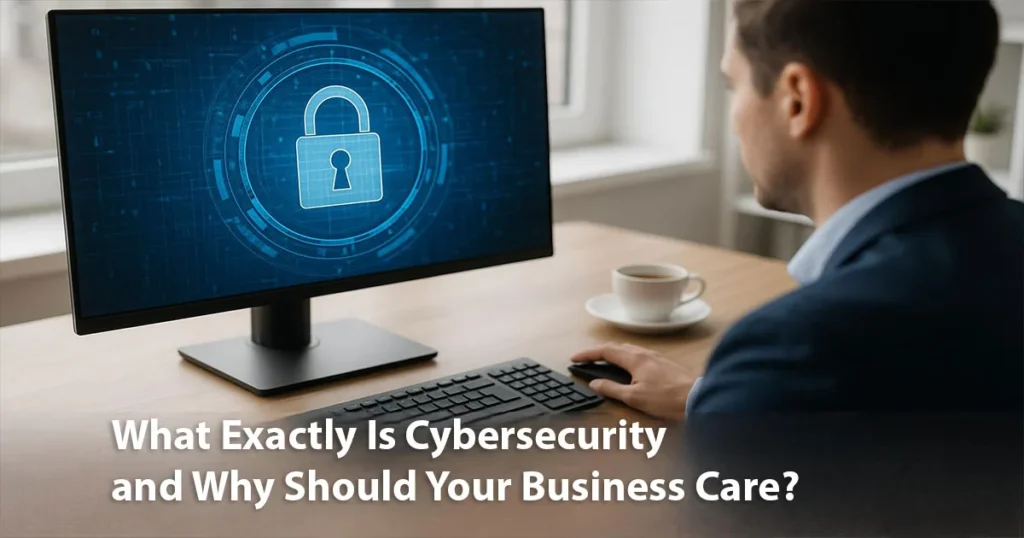Imagine waking up tomorrow to find your business completely locked out of its systems. Customer data compromised. Operations halted. Bank accounts frozen. This nightmare has turned into reality last year when 43% of the cyber attacks were made concerning small businesses, and 14% of small businesses were prepared to defend themselves.
The ugly truth is this: cybercrime is going to cost companies up to 10.5 trillion dollars by 2025, and as such, it is more lucrative than any drug trade ever was. But the best news is that no matter how weak your business is, ignorance about the protection that cybersecurity offers can turn your company into a castle that hackers will not even bother touching.
What Exactly Is Cybersecurity and Why Should Your Business Care?
A good cybersecurity does not only entail the use of an antivirus. It is a blanket that keeps your business safe in terms of digital property, customer confidence, and the bottom line, facing more and more savvy attacks.
The aspect of cybersecurity is like the immune system of your business. Like how your body has several layers to protect against illness, such as skin, white blood cells, and antibodies, good cybersecurity gets between your assets and the cybercriminal.
Cybersecurity in business protection goes much further than data breach prevention. It is all about ensuring business continuity, building and retaining confidence in customers, and providing the capability to grow in our networked digital economy. Analyzing cybersecurity as a competitive advantage as opposed to the necessary cost, this practice starts paying off when it is conducted validly.
The Facts Propose a Cybersecurity State for Businesses
The statistics paint a sobering picture of today’s threat landscape. More than four in ten of all cyber breaches affect enterprises having fewer than 1,000 employees, which confirms that size is no issue when it comes to cybercriminals, but vulnerability is.

Current statistics show that the average number of cyber attacks per organization per week is 1,876 in the 4th quarter of 2024, which represents a shocking 75 percent increase between 2 years. It is not a fashion phenomenon but an epidemic.
The financial implication is what is more frightening. They most often spend 826-653.587 dollars on cybersecurity incidents, and many never get out of a big breach. What is more threatening, the average expenditure of small businesses on cybersecurity software is only $2,000 annually, which in most cases is not enough to protect against comprehensive attacks.
The geographic spread tells its own story. Most Canadian small to medium-sized businesses experienced an attack in 2024, with 72% of the falling, and 65 percent of Mexican businesses displayed increased malicious attacks. No region is immune.
But here’s what these numbers mean for your business: cybersecurity isn’t optional anymore. Most of the small businesses, 60 percent, indicate that cybersecurity threat, malware, phishing, and ransomware, is a priority; and it should be.
How Cybersecurity Helps Small Businesses: A Step-by-Step Protection Framework
Step 1: Establish Your Digital Perimeter
The place on the front line of defense starts with the knowledge of what you are defending. Have a holistic checkup of all digital assets, starting with customers to staff laptops. List all the portals of access to your network, such as Wi-Fi access, cloud service, and remote access ports.
Apply network segmentation in order to isolate areas in your infrastructure. This implies that, in case attackers compromise one component, they cannot expand or move easily at sideways easily in your whole system.
Step 2: Secure Your Human Firewall
Your greatest weakness and biggest source of protection at the same time are your employees. Conduct frequent cybersecurity training, not just in dull PowerPoint presentations. Develop legitimate awareness through real-life situations and mock phishing attacks.
Establish efficient procedures for detecting and reporting suspicious acts. Ensure that employees find it simple to pose questions about possible threats without being judged.
Step 3: Deploy Multi-Layered Technical Defenses
Effective cybersecurity for companies requires multiple overlapping security measures:
- Endpoint Protection: Put up the enterprise-level anti-virus and malware software on every machine. Consumer-level solutions are not avail to business-targeting attacks.
- Email Security: Email security has to include the use of advanced email filtering that can help to identify phishing attacks or malicious files before they get into the inbox of employees.
- Access controls: Embark on the use of multi-factor authentication (MFA) on all business systems. Unprotected with a password is the same as having your front door open.
- Regular Development: Have a good patch management. A lot of successful hacks take advantage of known flaws in old software.
Step 4: Prepare for the Inevitable
Suppose that some breach is inevitable and despite the most thorough defenses. Develop and regularly test an incident response plan that includes:
- Immediate containment procedures
- Customer and stakeholders’ communication protocols
- Data recovery processes
- Adherence to law and regulations measures
Step 5: Monitor and Adapt Continuously
Cybersecurity cannot be a single installation. Install constant monitoring systems, which will help notice a peculiar network behavior, intrusion attempts, and possible data leakage in real-time.
In case the firm has had any new types of vulnerability, then set regular security tests and penetration tests, thus making sure that the vulnerability is identifiable before the attacker can access it.
Common Cybersecurity Mistakes That Leave Businesses Vulnerable
Mistake #1: Treating Cybersecurity as an IT Problem
Many business leaders outsource their cybersecurity entirely to their IT department, but this is anomalous thinking. Cybersecurity now is a business risk that requires CEO attention and a big, business-focused cultural change.

Mistake #2: Focusing Only on External Threats
The second threat is called supply chain attacks and affects 15% of small business breaches in 2025. Your suppliers, trading partners, and even your employees could unintentionally turn into a conduit through which the attacker uses to infiltrate your network. Never forget about the threat of insiders and the risks of third parties.
Mistake #3 – You are Too Small to Be Targeted
Smaller companies are usually targeted by cybercriminals since they tend to be less secure, yet carry desirable information. Information about your customers, financial data, and business-related intelligence are all assets that sell on the dark web market.
Mistake #4: Relying Solely on Cyber Insurance
Even though cyber insurance may be big, it can’t be a substitute for proper precautions. The cyber insurance premiums are on the increase, and coverages are becoming more limited for the low-security posture business. Premiums in this cyber insurance market have increased nearly three times in the last five years.
Mistake #5: Neglecting Mobile and Remote Security
Since remote working has become permanent, it is important to secure remote connections and mobile devices. Most companies prioritize office security without worrying about workers and leaving them unprotected.
Advanced Cybersecurity Strategies for Maximum Business Protection
Implement Zero Trust Architecture
Look past the idea of perimeter-based security to one that supposes that no user or device should be trusted in the first place. Don’t believe but check. This practice will very much minimize the effect of successful break-ins.
Leverage Artificial Intelligence and Machine Learning
The most recent cybersecurity solutions are using AI to generate trends and discrepancies that the human expert may not pick up on. Such systems have the capability to sense and respond to threats within a few milliseconds and, in most cases, prevent damage.
Develop Threat Intelligence Capabilities
When it comes to how well one can prepare, it is better to know the particular threats that your industry faces. To be ahead of the new emergent risks, subscribe to threat intelligence feeds and also join the industry security forums.
Create a Security-First Culture
Ascend the virtual security aspect from a compliance factor to a competition factor. Once the employees realize how their security-sensitive actions can safeguard the company, as well as their jobs and their customers, they will be very much engaged in your defensive mechanism.
Measure and Demonstrate ROI
Instead, it took organizations that use MDR services the shortest time to get back to business even after a major cyberattack, with nearly half (47%) reaching full recovery within one week, in spite of nearly only a fifth (18%) of them that only use endpoint protection returning to business. Monitor the metrics to show how you are converting your investments in security to business value.
The Business Benefits Beyond Protection
Good cybersecurity not only prevents attacks, but it also contributes to business expansion. Companies that have rather good security postures experience:

- Improved Customer Confidence: Customers are more likely to go to a company they can show that shows it practices solid data protection. In competitive companies, security becomes a competitive advantage.
- Effective Operational Efficiency: Intelligently developed security systems do not complicate operations; instead, they make them smoother. There is single sign-on, automatic backup, and secure remote access, which enhances productivity.
- Regulatory Compliance: Active security will help in ensuring regulatory compliance to avoid heavy costs caused by fines and legal issues.
- Better Business Continuity: When you make good and protective investments in security, it will future-proof operations against any emerging threats and catastrophic losses over the long term, such as sustained insurance premiums, higher regulatory compliance efforts, good brand image, and customer retention.
- Competitive Advantage: When security incidents are rampaging, competitors halt their operations, but your business continues to go strong with the market share and customer confidence.
Taking Action: Your Next Steps
The goal of cybersecurity protection is not the quest to achieve perfect security but to make one a tougher target than the competition or a more business nimble. Cybersecurity ROI does not merely concern itself with loss prevention. It makes business run securely and confidently.
Begin by conducting a thorough security evaluation to know your present insecurities. Then make improvements prioritized according to your own risk profile and according to business needs. Note that an implemented and continuously followed cybersecurity plan is the best plan.
Whether or not your business will need to deal with cyber threats is not the question; it is being ready in case they strike. Once 15.1% of the organizations have decided to invest more in information security in 2025, the previous ones will have an enormous advantage compared to the latter.
So, what is the initial cybersecurity enhancement that you will do this week to safeguard your company against the threat of tomorrow?
FAQs: Cybersecurity for Businesses
How do you start guarding cybersecurity?
- It is always good to start with a complete audit of your systems. Identify the expired, bad passwords and vulnerable access.
What can small businesses do to deter cyberattacks?
- Educate employees, implement reliable software, and update it on time, and before doing a backup of the essential information.
What are the reasons why businesses should invest in cybersecurity services?
- Various expertise, tools, and constant monitoring are available in professional services, and this is what is lacking in most in-house teams.
How frequently ought the security training to be revised?
- Twice a year at least. Periodic updates keep the teams alert of new threats.
Are cybersecurity tools expensive?
- Not necessarily. There are scalable solutions for every budget, and they’re far less costly than a cyberattack.

